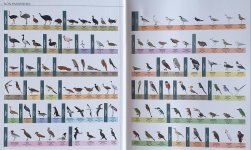I am looking forward to this book. My understanding is, however, that Tomasz, remarkably, makes his artwork traditionally, possibly with an airbrush. The perfect appearance of computer graphics is his style.
Actually, I may be doing him injustice. Tomasz started making such art before computer graphics developed, so he didn't imitate it. Possibly scifi stories imagined that computers would produce such a smooth art in the future. Only people thought that such a smooth picture must be made using a computer.
There was also another wildlife artist in Poland, late Jerzy Desselberger, who developed a style of straightening and smoothing bird appearance to the point of a symbol. He also worked before the time of personal computers. He is known from several books and especially postage stamps. And was also a long-standing member of Polish Rarities Committee, like Tomasz is now.









